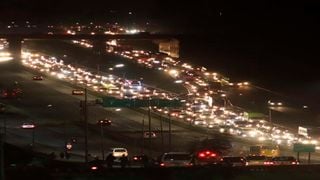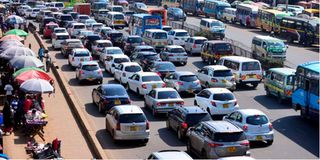
Heavy traffic on Thika Road last Friday as motorists try to beat the curfew. The situation has been made worse by rains which have been pounding most parts of the city.
| Dennis Onsongo | Nation Media GroupNews
Premium
Things get Thika: From a highway to the future to a traffic nightmare
What you need to know:
- Five years ago, you could drive at free-flow speed from Ruiru to Ngara. Today, you can barely move during the rush hour.
- Those living along the 50.2 kilometre highway say it takes up to two-and-a-half hours to get to town from Githurai.
Kenyans collectively breathed a huge sigh of relief when the Thika Superhighway was commissioned in November 2012.
With between four and six lanes on either side, the nation’s most ambitious infrastructure project was a road ahead of its time.
Travel time from Thika town to Nairobi dropped from two-to-three hours to half-an-hour. It set the stage towards a middle-income economy by 2030.
“The Nairobi-Thika superhighway is a national pride,” said President Kibaki. Today, the highway to the future has become a nightmare for motorists and commuters.
Five years ago, you could drive at free-flow speed from Ruiru to Ngara. Today, you can barely move during the rush hour. One of the worst sections is between Pangani and Junction 6 at the Survey of Kenya, a distance of 2.5km.

Heavy traffic towards the city center at Ngara in Nairobi on Thika Superhighway in this picture taken on August 25, 2020.
Those living along the 50.2 kilometre highway say it takes up to two-and-a-half hours to get to town from Githurai, a distance of just 16 kilometres. The curfew has worsened the situation as motorists stay longer on the road.
In the morning, traffic begins at Roysambu as early as 6am and sometimes it lasts for five hours. In the evening, it stretches from the CBD to Roysambu, 11 kilometres away.
Lately, traffic has worsened due to the construction of the Nairobi Expressway. Motorists from as far as Kitengela and Mlolongo use the highway via Outer Ring Road to escape the gridlock on Mombasa Road.
This has forced thousands to adjust their daily programmes with many being forced to leave home before 6am to make it to their places of work on time.
John Nyoike, a Kasarani resident, says before the pandemic, most evenings were chaotic and recalls getting home as late as 11pm. “On such occasions, I would question the logic of living in this side of the city,” he says.
Traffic nightmare
Things get thick in Muthaiga at the section where Kiambu Road – also a traffic nightmare – joins the highway.
Motorists from Kiambu town form long winding queues on the single-lane road, before joining the underpass that leads to the two main tributaries to the CBD.
The result is a traffic gridlock all the way to the CBD. While experts attribute this to a design flaw at the Muthaiga section, the Kenya National Highways Authority (KeNHA) Director-General Peter Mundinia says the problem is elsewhere.
“The government had planned to build Thika highway and expand Uhuru Highway at the same time. Traffic spills over to Thika Superhighway because Uhuru Highway and Mombasa Road are not efficient,” he says.
Transport Cabinet Secretary James Macharia says the Expressway will ease congestion on the highway.
“There are a lot of inconveniences as people are spending longer hours in traffic. That’s why we are constructing the Expressway. If there was no traffic congestion before there would be no justification to construct the highway. The pain will soon be over,” he says.
As of 2006, Thika road served about 60,000 vehicles a day. The number has ballooned to over 150,000 in the last decade, according to various studies. This translates to a growth of about 150 per cent.
Real estate boon
The highway led to a real estate boon as residential and commercial hubs sprung up, marshalling demand for land and property the north of the capital. Impressive real estate projects came up after the completion of the highway, with Garden City, Thika Road Mall and Juja City as some of the landmarks.
In 2012, there were only two public and one private university between Nairobi and Thika. Now there are more than 11 private universities with campuses along the highway and many mid-level colleges cropping up.
“You can never invest yourself out of congestion, it is very difficult. The only way to do it is to bring in efficiency mass movement and that is why we are constructing the BRT,” says Mr Mundinia.
More on this: The changing face of Thika town
Last year, KeNHA began re-carpeting the service lanes, which also contributed to traffic snarl-ups. The Nairobi Metropolitan Transport Authority (Namata) is now putting up infrastructure on the road that will be used to operate Kenya’s first Bus Rapid Transport (BRT) system.
Construction of the BRT means at least one lane is shut down to traffic at different sections during the day or night. When the BRT is done, one inner lane on either side will be sealed off to private motorists.
While this will make it easier for those using public transport, the Motorists Association of Kenya says it would create congestion.
“Congestion will be worse once the right lane is reserved for BRT as the other two won’t be enough for 150,000 vehicles, which ply on each side of the highway,” says Peter Murima, the association’s chair.





